

Over 70% of FMCG categories are predetermined before shoppers enter the store. Most of the items bought in supermarkets are already determined by routine before the shopper walks down the aisle. Yet there's a massive opportunity for 28% of the product purchases where impulse purchasing still reigns. The question is, what categories do shoppers engage with instore?
The Nielsen Category Shopping Fundamentals survey shows more people go to the supermarket to buy milk (57%) than any other item. Now you know why Coles launched its massive $1 a litre own brand milk campaign to grab share from Woolworths. Yet milk is one of the least considered decisions shoppers make at point of sale. Over 70% of shoppers aren't engaged by the category in the store.
It's a similar story for pet food and toilet paper. If you're a marketer of these low engagement instore categories you will get a better marketing ROI from a brand advertising campaign or an incentive before people go shopping.
Low engagement products don't benefit well from instore merchandising
Prospects who are less interested in your product instore are best marketed to out of store. From flyers to shopper dockets, catalogues to mobile promotions driving people to the store you will have better impact than attempting to get their attention while on autopilot in your category aisle. Packaging and instore merchadising is also less likely to switch customers between brands than other categories where people are actually paying attention.
However over half the shoppers surveyed are engaged by the process of shopping, just not with every category. So it follows knowing which category a product falls into helps marketers decide where to best invest in marketing.
The high engagement FMCG categories are frozen snacks and desserts
Shoppers are more engaged by more indulgent purchases like frozen desserts (64%) and infrequent purchases like toothbrushes (64%). Here is a snapshot of what shoppers are looking at with their brains switched off versus on:
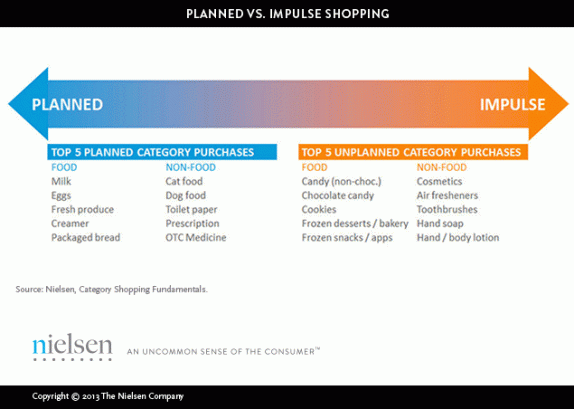
Categories with high engagement are better served by product innovation, instore merchandising and promotions and eye catching packaging.
Our marketing for Pacific West frozen seafood and snacks was centred on creating news and a fresh take on seafood. More adventurous choices has proven to be a more appealing strategy to the predictable product and positioning of Birdseye and I&J. Seven years of year on year growth for Pacific West shows what a difference it makes when you leverage an engaged instore audience.
Read MorePugs & Kisses & Christmas Wishes

(Click to Play)
A sincere thanks to our friends and colleagues for sharing our journey in 2013, UNO’s 13th year growing challenger brands.
We wish you and your family (and all creatures great and small) all the best for 2014.
Once again rather than send cards, we are supporting four koalas through the caring efforts of The Koala Foundation.
Best wishes from the UNO family.
Read MoreAIDS ads that changed our lives: If it's not on, it's not on

Australia faced a big problem in the 80s: AIDS was killing us
In the late 1980s AIDS was spreading unchecked in Australia amongst sexually active adults with multiple partners, homosexual males and intravenous drug users. Most people had no idea how you could catch it and there was no known cure. The only certainty was if you found you had AIDS, it was a death sentence.

The first government advertising campaign to raise awareness of the issue had failed to address the spread of AIDS. While “The Grim Reaper” ads certainly gained attention, the messages had not connected with those at risk and had not changed unsafe sex practices.
Indeed the Grim Reaper had simply scared the general public, especially kids and older people, without offering a compelling safe sex message. In charge of the government's AIDS awareness task force, Ita Buttrose had acknowledged the mistake the Grim Reaper fear campaign had been. The agency responsible that she'd appointed was fired and we were asked to implement our campaign they'd originally passed over for the Reaper.
The creative solution: "next time you go to bed with someone, ask yourself..."
"...how many people are you really going to bed with?"
You can't scare people into doing what's good for them. In fact, it's human nature to reject being told what to do. The art of persuasion often begins with starting a conversation that acknowledges the audience's point of view. And builds from there with an undeniable logic.
This commercial for the first time educated the community it wasn't "other people" who got AIDS, it was potentially anyone who went to bed with someone for unprotected sex.
Shot by Ray Lawrence (who went on to direct Bliss, Lantana and Jindabyne) my AIDS "beds" ad was made before the era of computer generated images. We put 800 real people into 400 real beds in the largest space we could hire in Sydney, the old tobacco bond store in Moore Park. The campaign worked in achieving the brief of raising awareness and driving behaviour change amongst those most at risk. The managers at Ansell would report an uplift in condom sales with every burst of our ads.
It's not often in this business you get the opportunity to really make a difference for society. It's usually baked beans and banking products.
Over three years as lead creative communicator I helped develop a series of undeniable messages that were created for specific audiences. From mass market messages on TV and radio, brochures for distribution in health clinics, English as a second language ads in ethnic press to bus sides and gay street press, posters on beats and stickers on public toilet doors.
The “Beds” ad which asked “next time you go to bed with someone, ask yourself how many are you really having sex with?” gave a graphic explanation of the chain of infection. The “Tell him if it’s not on, it’s not on” ads empowered people to demand their partners wear a condom. On the back of dunny doors in pubs across the country you couldn't ignore the big sticker of a condom clad erect penis with the words: "cover yourself against AIDS"
The outcome: Australia led the world in stopping the spread of AIDS
The integrated advertising campaign successfully raised awareness of AIDS amongst those segments of society most at risk of infection. The messages also reassured those not at risk and transformed the public view from one of “victims of AIDS” to an empowering safe sex message.
The creative campaign was instrumental in educating the public and changing sexual behaviour to succesfully reduce the transmission of the AIDS virus. The leader of Australia's health sector tasked with stemming the epidemic acknowledged the strength of the campaign:
“The message in this war against AIDS is a tough one – we know it will be controversial but we are certain it is the right approach, and it is backed by the World Health Organisation.”
Professor Ron Penny, National AIDS Council, 1988
This AIDS campaign is still recognised around the world as the most effective of it’s kind
Read MoreObstacles to innovation: A jeweller’s tale


Have you read the retail sector is finally looking up? Unfortunately not for everyone.
A friend of mine is one of Australia’s leading luxury jewellers. This year his turnover is down 20% and the word in the trade is over two dozen high-end jewellers around Sydney are on the brink of closure. That’s a lot in such a niche category. What has served them well for decades has seemingly evaporated overnight.
Where have the sales gone? A few years ago no-one had heard of Pandora as a brand of jewellery. Australia is now Pandora's fouth biggest market in the world. Or have you heard of The Iconic as a place to shop for fashion? Last week The Iconic turned over $1,000,000 of online sales in one day.
The simple answer for retail is to go online, right?
My jeweller’s quandary is he opened an online store with a similar offer to his shop and failed to gain any incremental growth.
Global changes demand an innovative response
It’s not just small high-end jewellers suffering from change. The global super premium brands are suffering the curse of ubiquity, Louis Vuitton sales are plummeting despite the increase in purchases of luxury goods by the emerging Chinese millionaire class.
We are increasingly seeing fashion conscious style setters seeking designs from unknown startups, boutique designers that they can tell friends they’ve discovered. Being in the know has more credibility with peers than wearing what any person with a Platinum card can buy in any Gucci store, from Guangzou to Fifth Avenue, Sydney to Roppongi.
Big brands have difficulty innovating as they have an aversion to cannibalising their existing business. It becomes harder the bigger and more established you are, which fortunately gives Australian challenger brands an advantage. The barriers to innovation have been identified in a Australia wide research by the Australian Institute of Management:
What’s stopping Australian businesses innovating

My friend said he had come across an offshore maker of silver jewellery, gold plated with semi-precious stones that look amazing but only retail for $300 to $500. His fear is if he stocked them no-one would continue to pay $3,000 to $5,000 for his similar looking existing product.
My suggestion to my jeweller friend is to take advantage of his ability to be more nimble than a Tiffany. He isn't facing the number one barrier to innovation, a lengthy development time and there is a way he can try something new with minimal risk. If he quickly sets up a small online store under a different brand, he then has no reputation to lose and can test the appetite for this new product.
The ability to test the mix of product and price is easily done with an online store. I’ve written in the past about how we can learn from fashion retailers that are innovating for pricing advantage.
The study shows the upside to trying new ways by becoming an innovator in your category is huge.
Innovation leaders Vs laggers: business performance ratings.
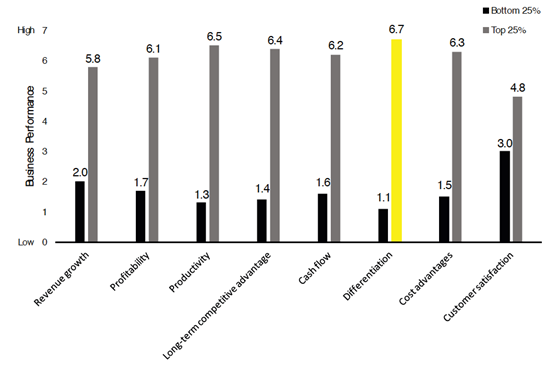
Innovation leaders are two to three times more successful than innovation laggers in terms of growth, profitability, productivity and cash flow. Risk obviously has greater rewards than business as usual. One UNO case study proves the point, Butterfly Silver was the first Australian Jeweller to apply a fashion forward procurement model to become a successful challenger brand.
Source: University of Melbourne and the Australian Institute of Management. 2013
Read MoreSales conversion rates: the facts

Sales call stats – how does your team rate?
48% of sales people NEVER follow up with a prospect.
25% of sales people make a second contact and stop.
12% of sales people only make three contacts and stop.
Only 10% of sales people make more than three contacts with a prospect
So if your sales people are typical of all sales forces, what are the consequences of only 10% of them calling on a prospect more than three times?
Conversion rates increase with sales call rates
2% of sales are made on the first contact.
3% of sales are made on the second contact.
5% of sales are made on the third contact.
10% of sales are made on the fourth contact.
80% of sales are made on the fifth to twelfth contact
Sure, it costs more for your people to call more than 3 times, but consider your return on investment when you factor in the typical conversion rates. Three calls and under only converts 10% of sales!
If your sales people are not following up, the stats indicate there is little to be gained by simply adding new names for them to visit. It also shows the value of building brand awareness before the sales person calls.
Source: Richter10. Thanks to Rick Allen for sharing
Why are most ads so bad nowadays?


Bartle Bogle Hegarty was the London ad agency every ambitious Australian creative wanted to work at in the 80s. They made a series of great ads for Levis including “laundrette”, came up with "Vorsprung durch Technik" for Audi, "The Lynx Effect" for Unilever and "Keep Walking" for Johnnie Walker whiskey.
BBH creative founder “Sir” John Heggarty will speak at a global advertiser conference in Sydney in March. He has already given an idea of what advice he has to for Australia's advertisers.
What is the state of advertising creativity today?
“It’s one of the best times ever to be in advertising but why is it the work is poor,” he told AdNews from his organic and biodynamic vineyard in France. “I don’t know of any other industry in the world that would say the way to succeed is to make a worse product. And we seem to be in that situation in advertising."
CEOs in Australia say they want creativity
More than anything else, a recent Australia wide survey of CEOs shows they want their marketing agencies to be creative. Yet one look around shows how poor ads are today.
The CEO of a financial services group asked me recently what killed the Australian ad industry? "The Internet?" he asked. "Globalisation" I answered.
The fact is, in Australia the biggest brands mostly run ads from somewhere else. They don’t care if their ads don’t work very well here, in the global scheme of things one year’s revenue in Australia can be surpassed in one long-weekend in Florida.
So I wasn’t surprised to see Sir John identify the cause of mediocre advertising. “You can talk about technology being the reason but for me the biggest issue is the globalisation of our industry. We don’t seem to be able to create work globally that has impact. I think marketers today are losing contact with people despite the fact they have many more ways of communicating with them.”
Meanwhile home grown ad standards are going down, down
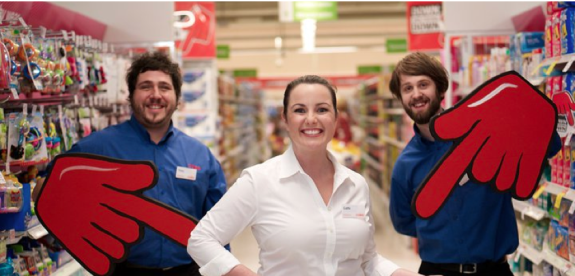
We are increasingly bomdarded with ads produced in-house by Australia's retailers, further driving standards down, down. Over 30 years creating ads has taught me great creativity sells. Especially when developed by local writers and art directors who are in touch with the essence of what makes Australians tick. I believe clients are best served by ads that tap into human insights, no matter how small. When told with humour or compelling gravitas a human truth will cut through where so called big ideas with big budgets and big name stars fail to connect with real customers.
Are you more inclined to buy from someone you like? I know I respond better to brands that have an endearing conversation with me, rather than a list of claims shouted at me, even when put to a jingle. The answer to appealing to customers doesn't lie in more data.
Sir John also warned about the dangers of data and analytics –
“Clients are desperate for salesmanship to be a science. They would love it to be. They would love to be able to say this equals that and this will be the return on investment so let’s do it. But they can’t. In the end it’s a judgment call you still have to make.”
Lets all hope more advertisers re-embrace the power of creative story telling, it makes better viewing.
Read MoreCustomer loyalty in Australia comes at a different price to O.S.

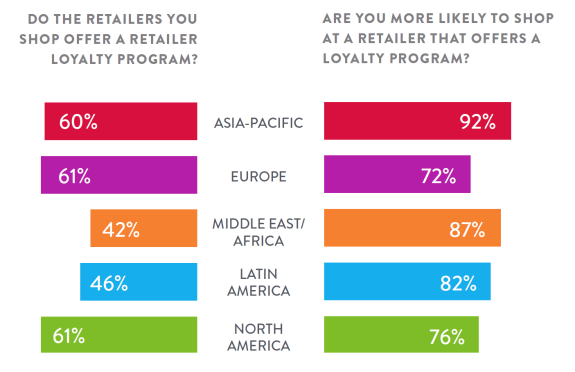
Our region ranks 1st in responsiveness to loyalty programs
We now have proof customers in the Asia-Pacific are the most willing in the world to reward businesses with loyalty. Whether you are in a service or product category, the good news for Australian business managers is your customers' loyalty doesn’t have to come at the price of discounting.
Don’t think global when marketing local
You can out-maneuver big brands that continue applying globally what works in their home market. Consider implementing strategies that Australian customers will reward with loyalty.
The US is introspective, remember it's the country that has a World Series with only US teams. Most US companies don’t have our local market's needs on their radar. Meanwhile, Europe’s big brands are struggling at home with a deflationary market. These parochial management mindsets offer Australian brands an unique opportunity. It's the perfect time to think and act local where big global players have a tendency to universally apply one strategy.
A global survey now shows us just how different Australian consumers are compared to the home town customers of global brands.
The Neilsen Global Report of Loyalty shows our customers are different
Unlike Europe and the US where 82% customers want discounts and free products as a reward, in our region we are less motivated (70%) than anywhere else by something for nothing. Here customers lead the world in valuing good customer service (53%) and exclusive deals (41%). The Customer Loyalty Report shows your customers want you to give them quality and service more than just price:
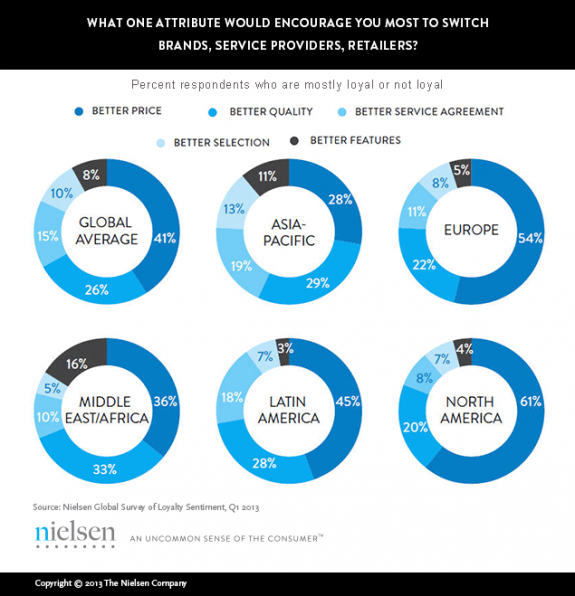
Loyalty programs can improve profits
UNO applied the disciplines of building a loyalty program around quality and service for Vivien's Jewellers. We replaced monthly cardboard in-window price promotions with quality themed creative store merchandising. We introduced a VIP loyalty program that emphasised exclusive product offers. Sales, discounting and price promotions were no longer frequent, being replaced with special occassion sales through invitation-only Wednesday night store openings. While Angus & Coote and Michael Hill were seen to be always on sale, we built a reputation for accessable aspiration.

Over 5 years we transformed Vivien's sales base from only 25% repeat sales to 75%. This also helped Vivien's double the number of profitable stores and ultimately sell the business at a category premium.
I continue to encourage our challenger brand clients to compete with the global competition by developing marketing strategies focused on what customers really value. The big guys often lack the ability to get close to the customer, let alone respond. You may have noticed over the last year a number of visiting global FMCG heads lamenting how hard it is for them to make money in the Australian market. Coles and Woolies forcing them to cut margins isn't helping.
Do you cut for share or innovate to grow?
Increasingly businesses nimble enough to canibalise their existing sales by trialing new products or services will gain market share in the long term. And because they aren’t discounting, those sales can be more profitable.
Spend your time looking at ways to make your customers feel understood and then invest in a creative communucation of your differentiated proposition. Let the global brands discount their way to local irrelevance.
Read MoreFrom the people who gave us wooden pillows – brand differentiation

Do you think it’s hard to differentiate in your category?
 A trip to Japan gave me a fresh perspective on how to make any brand stand apart from the competition.
A trip to Japan gave me a fresh perspective on how to make any brand stand apart from the competition.
Last month I bought a new mattress from David Jones Sydney city store. Each brand had the same proposition: sleep soundly and wake refreshed. Choose between hard or soft, affordable or expensive.
Talk about a lack of fresh ideas, the promise of a good nights sleep hasn’t changed since I worked on the Simons mattress account 30 years ago, or the idea of looking after your back when I marketed Sealy “Posturepedic” 20 years ago.
The Japanese have a strange way of looking at brand propositions
At least on first view this first world nation has some peculiar ideas about brand messaging. The English language isn’t used by 999 out of 1,000. And Japan has a proud history of maintaining thousand year old traditions. So this different background means common products are often promoted in totally different ways to our western approach.
A couple of weeks ago I checked out the merchandising of mattresses in a central Tokyo department store. Here are some pictures I took when the salesman wasn’t looking – mattresses marketed the way Nike sells shoes.
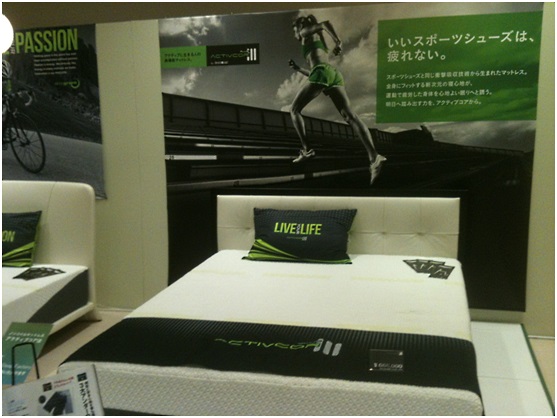

Nothing soft and fluffy about this positioning – “Activor, the next generation in sleep technology.” Hi-tech performance for the modern Japanese consumer.
Feeling inspired? Whatever your category, you can find inspiration from taking a completely different perspective.
P.S. Aussie mattress brand repositions for export market
Local mattress maker A H Beard has just launched in China. Unencumbered by any legacy in this new market, how are they differentiating? Their first mattress for Chinese consumers retails for over $20,000. That should set them apart.
Read MoreVale Scott Kennedy – one of NZ's finest artists
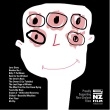
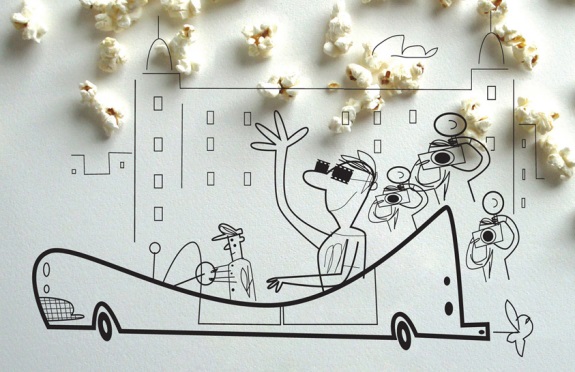
Our professional careers are sometimes touched by the most inspiring personal relationships. I was blessed with the early entry into my life as an Art Director by an artistic genius from across the ditch, Scott Kennedy. It was the early 80s and any Kiwi artist of promise had washed up in Sydney seeking a broader canvas.
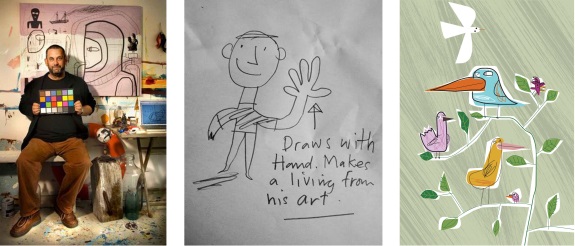
Scott bid us goodbye last week after a painful but defiantly good-humoured fight with cancer. At the end his hands wouldn’t work, but Scott’s creativity was always alive in his one of a kind headspace.

As you can see Scott’s view of life was re-expressed through the lens of 60s cartoon characters and tin toy robots and Dr Strangelove. His ex-US Army dad had relocated the entire family from California to New Zealand in the belief it was the safest place to be when they dropped The Bomb.
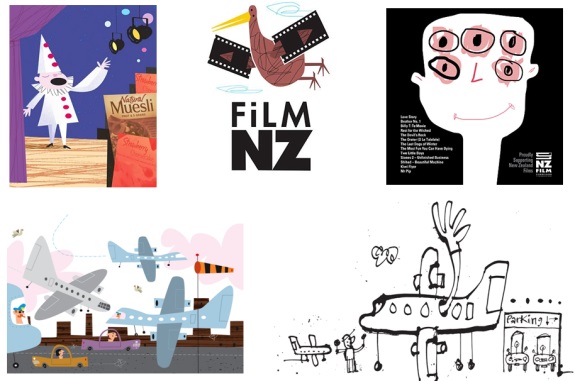
I loved Scott for his quirky humour, big heartedness and child like enthusiasm for new creative possibilities. Have a Captain Cook at Scott’s book covers for the popular How to… series, no surprises which is my favourite.
I write this while wearing Scott's "Joy kills sorrow" T-shirt, which is a fitting memorial to his precious time with us.
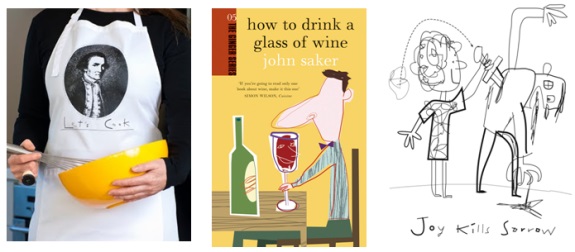
What CEOs want from an agency


The top 3 things CEOs and CMOs want from their agency according to a survey by the Communications Council are:
1. Innovation and creativity
2. Leadership
3. Integrity
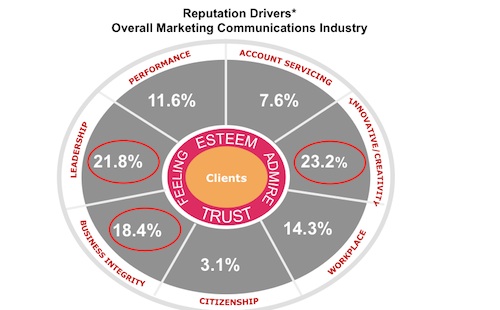
Funnily enough, the leaders of agencies put Leadership last.
Which could explain why three quarters of CEOs don't value marketers at the board level.
I wonder if this is a reflection of the transaction based relationships most agencies seem to be stuck in today. Whatever happened to “fearless advice”. It's what most left brain business managers want from right brain agency creative thinkers. Creative thought leadership is where agencies add value, not servile account management.
Perhaps it’s a consequence of a co-dependent relationship between ignorant brand managers and subservient suppliers. Meanwhile the smart business leaders appreciate the real value to be added is at the board level, with lateral and entrepreneurial advisors from outside their organisation helping them challenge traditional business models.
Read More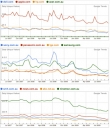
One of my clients attended a Social Media Marketing forum at Deakin University recently. He was surprised just how out of touch most marketing and business managers are with this medium as a means for promoting a business. The questions being asked were about how to control staff access to social media or how to post their brands’ advertising and collateral across the newer platforms.
This top down approach where management dictates the agenda no longer cuts it.
In the same way the Internet has empowered the public to access their news, music and entertainment whenever they want, not when the distributers choose to roll it out, Social Media is taking the online quest for information about products and services away from publishing and brand sites. Social Media is creating a vibrant forum for conversation about products, services and brands beyond the direct control of a company’s sales and marketing force.
The statistics show the rapid pace of change of where people are going online in search of information of all kinds.
Trend away from website visitation to Social Web
Google trends show over the last 2 years a significant decline in visitors to brand and media sites.

Boom in Social Media and content sharing
More people are seeking and sharing what they want online.

It’s no longer enough to have a brochure style website, you can no longer sit back while your salesforce distributes your marketing collateral and your marketing department runs ads telling the masses how good you are.
Everyone in your organisation and every one of your customers is now a prospective advocate for your business. Or they might be saying your competitors are better. You can’t control the conversation, but to compete today you need to formulate a social media strategy, coach your staff, create content of use to customers and prospects and contribute to the conversation in an open and honest way.
Small can succeed in retail against big budget incumbents
Growing up in sixties suburban Sydney the most exotic cuisine my family was familiar with was cabanossi on Jatz crackers. Father felt like a Tooheys or two and good on my mum, she knew Tip Top was the one. Fortunately, forty years of immigrant mothers from around the globe have helped expand Australians’ culinary horizons.
Family businesses show how to be a challenger brand
At the Food and Wine Expo held by Family Business Australia in Sydney in November, the influence of Nonnas was evident as third generation business owners showcased their gourmet products. Their time has come, statistics show the trend to gourmetisation of the Australian shopping basket has now reached beyond the specialist deli and ethnic store to the Supermarket.
Unlike most trade shows, what struck me at the FBA event was the friendly atmosphere, no hard sell, just an infectious enthusiasm for the products these families have been creating for years and a desire to share business stories. From the small catering company making their first tentative step into retail, through to a food service business that gave up on retail in the 70s, one story is common: the bigger challenge isn’t getting onto the shelves of Coles and Woolworths, it’s how to stay there and make a profit.
Two family businesses, Taylors Wines and Coopers Brewery, are testament to the magic ingredient for success in the retail market – the power of building a brand. Branding is what puts the power in your hands, not the channel’s. Building a brand takes more than one-off promotions, or advertising that simply says you are in store now, or paying for inclusion in catalogues with discount offers. To build a brand you need to invest in marketing over time to establish the brand story and your values.
Brand marketing delivers these benefits over a me-to sales approach:
Product
Easy to copy
A commodity
No special distinguishing features
What a factory produces
Shorter life cycle
Addresses functional needs
No identity
Products compete on price
Brand
Hard to copy
What consumers buy
Emotional fit with consumers
Level of confidence and trust
Longer life cycle
Addresses emotional needs
Have personalities
Brand can demand a premium
Fosters Group has destroyed shareholder value to the tune of hundreds of millions of dollars over the last decade by mismanaging the marketing of some icon wine brands, from Lindemans and Penfolds to Seppelt and Tollana. Meanwhile, family business Taylors Wines has stayed true to its five decade history with consistent product, packaging and promotion.
Nick Levy, the marketing manager at Taylors, wouldn’t dream of throwing out the heritage of this family business, whereas corporations time and again allow each new brand manager to make their mark by changing the label their customers know and love to chase a fleeting fashion. Often the new look comes at the expense of long won recognition. Similarly, downgrading a product’s quality to maintain margin or constantly price-cutting to gain share ultimately destroys brands.
Yes, we live in a time where the pace of change is so much faster, yet taking the time to establish what you stand for, developing a dialogue with your customers and creating a sense of authenticity are increasingly valuable tools in a world where global producers can pitch to your retailer with a cheaper knock off product as soon as you leave the buyer’s office.
If you value what you have to sell, it pays to remind your customers as often as you can of why they should love you. Now you can afford to. New technologies, data intelligence and eCommunications now enable challenger brands to compete successfully with the large advertising budgets of corporations.
So find the true benefit of your offer and actively market it. As Revlon said, having built an empire with brand marketing, “we don’t sell cosmetics, we sell hope.” Worked on my mum.
This article first appeared in Business Insight
Leave traditional marketing to your competition... Now there are smarter ways to connect

To make the most of a marketing budget there are now smarter ways to integrate social media and search optimisation.
Many struggle to keep abreast of the changing landscape, while companies that take advantage of 'eCommunication' will benefit from increased efficiencies, decreased costs and improved customer engagement.
Traditional marketing funnel view of prospects...

Medium and message is aligned to where the audience is in the funnel, information is controlled by the brand.
The decision making process in an e-connected era...
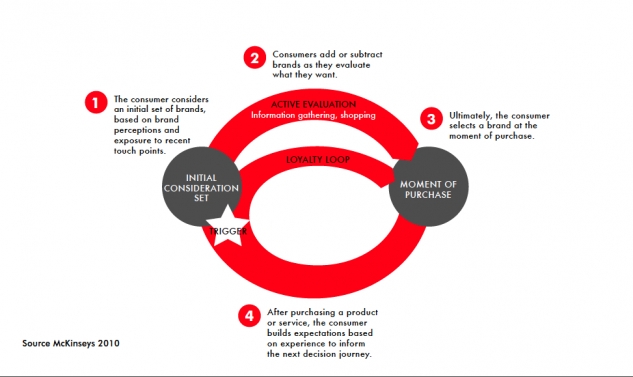
Time to replace the old touchpoints with a new mix
The journey is no longer simply linear, the customer now has control over what they see and read on any subject. The audience enters, leaves and re-enters the decision making process more often, with more access to information from more sources when they want it.
Your eCommunications checklist
Whether your business is B2B or B2C, it’s no longer enough to think in the linear way of out of home, in store (channel), at home. Here is a new set of options which UNO utilise to supersede or integrate with existing programs:

Are you a retailer or publisher, advertiser or educator? The Internet has blurred the lines.
There used to be clear delineations between product manufacturer/creator, channel/distributor, retailer and end consumer.
Enabling this traditional marketing model there was mass media. Advertising mad men then helped consumers to embrace the products and services they hadn’t heard of and didn’t know they needed. Now the interconnections of the Internet have transformed the sequence of commerce and marketing.
Customers are now researching every category online
People have a need? They research online for themselves in the safety of their own home, avoiding the charms of advertisers and brand collateral, packaging and point of sale merchandising. The empowered consumer accessing product knowledge on the web via forums, chatrooms and reviews is beyond the charms of the seasoned salesman on the shop floor.
Even more disconcerting for the traditional retailer of a product or service is the emergence of the medium no longer just being the message, but now a vertically integrated marketing model.
From books to money management, every category has been turned inside out and upside down. What was linear, is now a 3D demand and supply freeform organism.
Consider books. A hard back would come out, early adopters would pay a hefty premium, soft cover would follow, trends would be noted, popular titles would have second and third editions printed and distributed, blockbusters would be advertised and the retailers would rake in the cash and the publishers would cover the costs of the many failures by most of their authors.
Then Amazon cut out the middleman, and now with the Kindle is changing the distance from content to delivery even further, you can now download and store a library of 3500 “books” on a device that is close to the price of a couple of hardbacks. So if there is no need to print and distribute, does the author deal direct with Amazon, seeing the retailer become the publisher?
Even services aren’t untouched by the digital revolution
Take for example Superannuation Funds. If you work you have one, no wonder there are thousands of funds competing for a share of 9% of your salary.
For Australian investors there used to be 3 Clayton’s choices, the choice you have when you don’t get a choice. If you were a blue-collar worker your employer put you into the Industry Super Fund that was created for your industry. If you were a public servant, you were automatically in your government fund. White-collar workers had a modicum of choice, the local Insurance salesman would flog a retail fund and benefit from the handsome commission and trailing fees.
Not any more. Super Choice means most can now choose their fund. Those who are motivated research online, in fact 50.6% do, whereas only 12% turn to newspapers and a mere 3% magazines. So while all those funds are spending hundreds of millions advertising in mass media, savvy investors that are shopping around are stumbling upon a vertically integrated model. Fairfax Digital owns InvestSmart, a licensed financial services business that bought Direct Access, which was a discount retailer of funds. Fairfax in its wealth and business sections publishes articles on super and investment. On the same pages are links and comparison tools branded InvestSmart. These tools and tips and comparison lists educate the Super Shopper. Then when they are ready to buy, fulfillment is just one click away for a fee a fraction of the traditional adviser model. So the publisher becomes the retailer.
So does all of this mean consumers are better off? The fastest growing and the biggest segment by value of the 1.4 trillion dollar Super category is DIY. Self Managed Super offers investors the allure of control. Pity the average SMSF underperforms the average Industry Fund and has higher costs, until someone challenges the model that is.
Whether you are a retailer or a service provider, a financial services business or a manufacturer, it’s now time to reappraise your marketing model before your competition beats you to it.
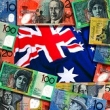
Marketers have spent the last decade watching Woolworths maintain dominance in grocery while Coles failed to focus on customer needs and treated suppliers with disdain. Under Wesfarmers things are starting to change, yet the biggest fight in retail over the next decade is more likely to be driven by a huge shift to buying online.
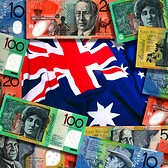
While Australia’s Westfield has over 30 years fine-tuned a profitable model to encourage a visit to the Mall, as therapy for the modern empty soul, the Internet is on the cusp of changing the behaviour of society in an equally profound way.
It’s already happening. In 2009 Australians spent $24billion on retail online according to research commissioned by eBay and predicts a 40 percent increase to $32.8billion in 2012.
Australia’s retailers are falling behind the rest of the world in grabbing a share of the online retail spend. "As Australian retailers struggle to build effective online presence, overseas competitors are taking advantage of the gap in the Australian market and are currently taking around 40 per cent of Australia's online retail spend," according to PayPal MD Paul Feller.
"There is a huge opportunity for retailers to capitalise on the growing online marketplace in Australia. In the last six months alone the average consumer spent $1,223 on online shopping, an increase of $130 from the second half of 2009."
So Westfield has to balance an online strategy with keeping footfall high in the malls to keep those retail tenants in biz. No easy task, now that broadband speeds and speed and reliability of delivery through the mail are narrowing the gap between online purchase and the wardrobe.
Who shops online?
My daughter buys most of her clothes online from the US and UK for a fraction of local prices, my son buys his music and sound gear from all corners of the world and Amazon keeps my partner well read. Online purchases of all sorts of items will become the norm, especially as the ways to enhance the shopping experience online grow.
In the past you would see the latest fashions in a magazine spread, be exposed to an ad on TV with Megan Gale for David Jones and go the mall to try it on. Now the whole experience can be completed online. The Ceros platform is being used by the likes of Sears, Tesco, Virgin and IKEA to show product and close a sale using a rich media eMagazine. Have a look. We’re already using it to help our challenger brand clients leave their competition behind.
Read MoreMarketing tips for fund managers
Fund managers can make more money by marketing. The trick is to know what marketing is exactly...
I have a passion for following fund managers’ performance and comparing how they stack up against their investment philosophies. There are a handful of fund managers who stick by their principles and deliver above average results through the ups and downs of the markets. What surprises many managers is that investment doesn’t always come flooding their way when they are doing better than the index. There are plenty of examples where poor performing funds continue to dominate in the competition for FUM.
It’s not enough to rely on BDMs and the distribution and sales channels; every fund is out there building relationships with the instos and advisers. The commercial reality is rooted in human nature; ultimately the salesmen who managers are relying on to recommend a fund will go for the easy sell. And as we’ve seen, performance can’t be the only draw card or there wouldn’t be 19,500 funds on the market where the biggest generally aren’t the best. It would be a mistake to think the end of commissions will result in a rush to quality, inertia and confusion will see to that.
It’s time the better managers tried something new to most in the industry. It’s what’s been honed and crafted by the world’s most successful companies, from Apple to Armani, Mercedes to Mars: it’s marketing. In a world of multiple choices, marketing is one of the few tools that can make a significant contribution to the success of a business.
The financial services industry still confuses sales and distribution for marketing
It isn’t. Marketing takes the ball the first fifty metres and sales kick the goal. Then it’s marketing that continues to remind investors why they made the right decision choosing your fund, so they’ll stick by you through the inevitable bumps and falls. And invest with you again and again.
In the words of Wikipedia, marketing is the process by which companies determine what products or services may be of interest to customers, and the strategy to use in sales, communications and business development. It is an integrated process through which companies create value for customers and build strong customer relationships in order to capture value from customers in return.
Manage the image you create for your brand and how you promote it
From product design and the language you use, your logo and stationery, the look and imagery in brochures and PDSs, the content and design of e-newsletters, what is on your website and how it is presented, to advertising and sales collateral. When every part is working together in a co-ordinated fashion the whole adds far more value to the business than the investment in the parts. And just like investments, managed well marketing delivers compound returns.
Over the years I’ve found integrated marketing works just as well for financial institutions as it does for baked beans. Research by the School of Management and Finance, University of Nottingham showed back in 1998 the similarities emerging even then between consumers’ responses to financial services ads which featured the same cues as ads for fast-moving consumer goods (FMCG) and the influence on subsequent purchase decisions.
Put simply, when it comes to proven ways to make money, fund managers can get a healthy ROI from marketing. For evidence, they just have to ask about the results of my many marketing experiences of 30 years, from banks to baked beans.
Signs of the times... who has the time?
Outdoor advertising is diminishing in effectiveness, like many traditional mediums
Not surprising when you think about the increasing clutter advertising billboards have to compete with for attention.
In the Drive section of the SMH the other day one motoring journo observed: “I went to a suburban shopping district and counted 19 road signs clustered around the first intersection. There were 55 road information messages in about 100 metres. Even when travelling at 40km/h you are left with just nine seconds to read them". In the book Traffic, Tom Vanderbilt states the average driver must process 1340 pieces of information every minute.
So recently when a client asked UNO to review their annual advertising media budget we weren’t too keen to recommend continuing to spend several hundred thousand dollars for one poster above the M4.
Old habits die-hard, the CEO drives to work each day and passes that one sign. We couldn’t convince management that for about 20% of the cost of that one sign they could develop an ongoing relationship with their customers using the latest Web2.0 technologies and build a valuable database for future use.
While traditional media companies like Eye Corp continue to sell posters, a medium that hasn’t changed for a couple of centuries, newer more effective alternatives are emerging. (When the price is right.) ROI marketing starts with understanding the real stats.
Innovation in signage
Recently Ryan Simpson of Val Morgan showed me the latest research on their innovative take on signage, large video screens in shopping centres.
While I always take statistics with a grain of salt, the figures reflect the relationship between clutter and proximity to where the purchase can be made. Despite the amount of billboards, busbacks and taxibacks that shoppers must have passed on their way to the shops, almost 50% say they didn’t notice any advertising. 30% remembered noticing billboards, whereas this new moving screen medium within shopping centres was noticed by over 70% of the 1,000 people surveyed by Nielsen research.
Pity I didn’t have those sorts of stats on hand when I tried to talk that client out of spending a large chunk of their budget on that one sign.
Bigger ad budgets usually mean greater waste
Marketers don't always get what they pay for. I recently met with the new regional head of one to one marketing of a world leading brand. One to one is their fancy term for online. This new manager has been brought in from the USA to determine how the millions of dollars they spend annually in this region can deliver a better return.
Mid size companies can learn from the mistakes of larger marketers with larger budgets. Some of the areas of waste this expert has identified in just a few months are listed here:
Marketing budgets managed within silos is inefficient
Some products have budgets too small to make any impact, while others spend more than necessary because they have a larger allocation. Simply by adding an overview of expenditure across the portfolio would deliver a win win result.
Too many contracts with too many large agencies can drive a big spending approach. Marketing managers with little experience are often given average strategic advice and average creative executions. Large agencies are inclined to overspend on media exposure, (with commissions it's an easy earn).
Set marketing KPIs upfront
Smarter marketers know investing in more management time upfront determining objectives and KPIs, with strategic intellect and strong creative can mean a much smaller media spend can deliver greater impact, more leads and higher conversion rates. There is also an inevitable diminishing return factor from spending more, if someone sees your ad two or three times and still hasn't bought, spending more to show them the same proposition four or five times is simply a waste of money.
There is value in retained knowledge
Years of collected data, research results, campaign learnings and customer databases are often ignored with each new project. Every campaign can and should add incremental value to the next. Take a test and learn approach, rather than a big spending one-off hit. This is one of the fastest ways to implement ROI marketing.
Fortunately for my mid sized clients, I've found over the years insight led creative marketing can punch above it's media weight time and again.
Read MoreGM a victim of launch and leave
For General Motors, big has not proven to be better. From 50% market share to 20% and bankruptcy in just 40 years has partly been blamed on an inability of management to move with the shift from big gas guzzlers to smaller cars. The disastrous purchase of Hummer in 1999 showed how recently GM thought big still had a big future. Time has proven there were only a few big spenders like Renee Rivkin who bought these massive buckets of bolts, obviously not enough to pay the massive borrowing costs.
Less obvious to the public, and of more interest to marketers, are the views being expressed that a lack of advertising support has played a very significant role in the rapid market share loss to the Japanese car makers.
One example was the surprisingly upbeat statements by the head of marketing of GM, he is excited by the prospect of having less brands to support with his marketing budget. With the jettisoning of divisions like Pontiac, he'll be left with just four brands to promote, including Chevrolette and Cadillac. This he trumpets will give him a chance to compete with the same ad budget as Toyota.
In an obituary of the once market leading General Motors, The New York Times blames management for a failure to support it's product with advertising.
Advertising works, The New York Times says so
It points out GM finance staff wrestled with product developers and marketers, thus causing GM to fall victim to a practice called launch and leave - that is, putting product on the market, then failing to support them with advertising.
As someone who has played a part in helping numerous businesses grow share by using smart, creative advertising, this is a particularly public example of the consequences of not believing in the power of marketing. If you ever have to justify to management the wisdom of investing in advertising, when so many accountants seem to view it as a discretionary cost, use this following quote from a past executive of GM who was part of the team that created the successful Pontiac GTO in the 60s and wrote the book about it Glory Days...
Image is everything in building brand equity
Nobody gave any respect to this thing called image, because it wasn't in the business plan. It was about "when is it going to earn a profit?"
As the New York Times points out, over the years the marketing skeptics at GM became practiced at the art of explaining their problems, attributing blame to everyone but themselves.
Read MoreIt pays to trust people with passion
In the last week a visit from a chimney sweep and a conversation with a successful Australian manufacturer reminded me of the value of passion in business.
I was surprised when the chimney sweep asked when was the last time my chimney had been cleaned. Annually didn’t make sense to him judging by what he saw with his fancy mirror... unless I burn 20 tonnes of wood a year, which I don’t. I was quickly impressed by his enthusiastic run down on the finer points of proper chimney maintenance. This man has been cleaning chimneys for 27 years and was still getting a buzz from helping people solve their dirty flue problems, he described the joy solving more difficult challenges and leaving customers with fires that draw like new. His fee was no more than the company that has under serviced us over the last few years.
Whatever service you need, find a practitioner who is passionate about what they do
One of my long standing clients, going on nine years now, makes plantation shutters. Marion Mikkelsen of Open Shutters is passionate about her product, and has built a brand over this time that has proven resilient against the onslaught of cheap Chinese imports. She is so passionate every aspect of her business is constantly reviewed with the objective of constant improvement. She refuses to compromise, so instead of cutting corners to save costs this business runs on a successful program of creative thinking, R&D, staff training and manufacturing innovation.
This passion shows in her product, which my wife thought was the best when she did her pre-purchase research for our home. It was only a few years later I coincidentally won Marion as a client... it is great to be able to market a product you’ve bought yourself.
Why do so many business people mistrust each other?
Over 20 years this pioneer of timber shutters in Australia has led with product innovation and with UNO’s marketing help driven the growth of the category. Yet Marion lamented this week how it’s only after many years her distributors are beginning to trust what she says about her product and her overarching belief in the necessity to fulfill the expectations of consumers. How could so many small business owners not recognise the genuine passion displayed by Marion?
I shouldn’t be surprised, I often find business prospects are cynical of what I have to say about how smart marketing can help their businesses succeed. I’m passionate about what I can do to help people, however it’s even harder to be believed when I work in an industry that the public constantly ranks at the bottom of the trust table alongside used car sales and real estate agents.
Read More




Scan the QR code for our contact details.
Download the Neoreader app.
© COPYRIGHT 2013 UNO marcomms Privacy